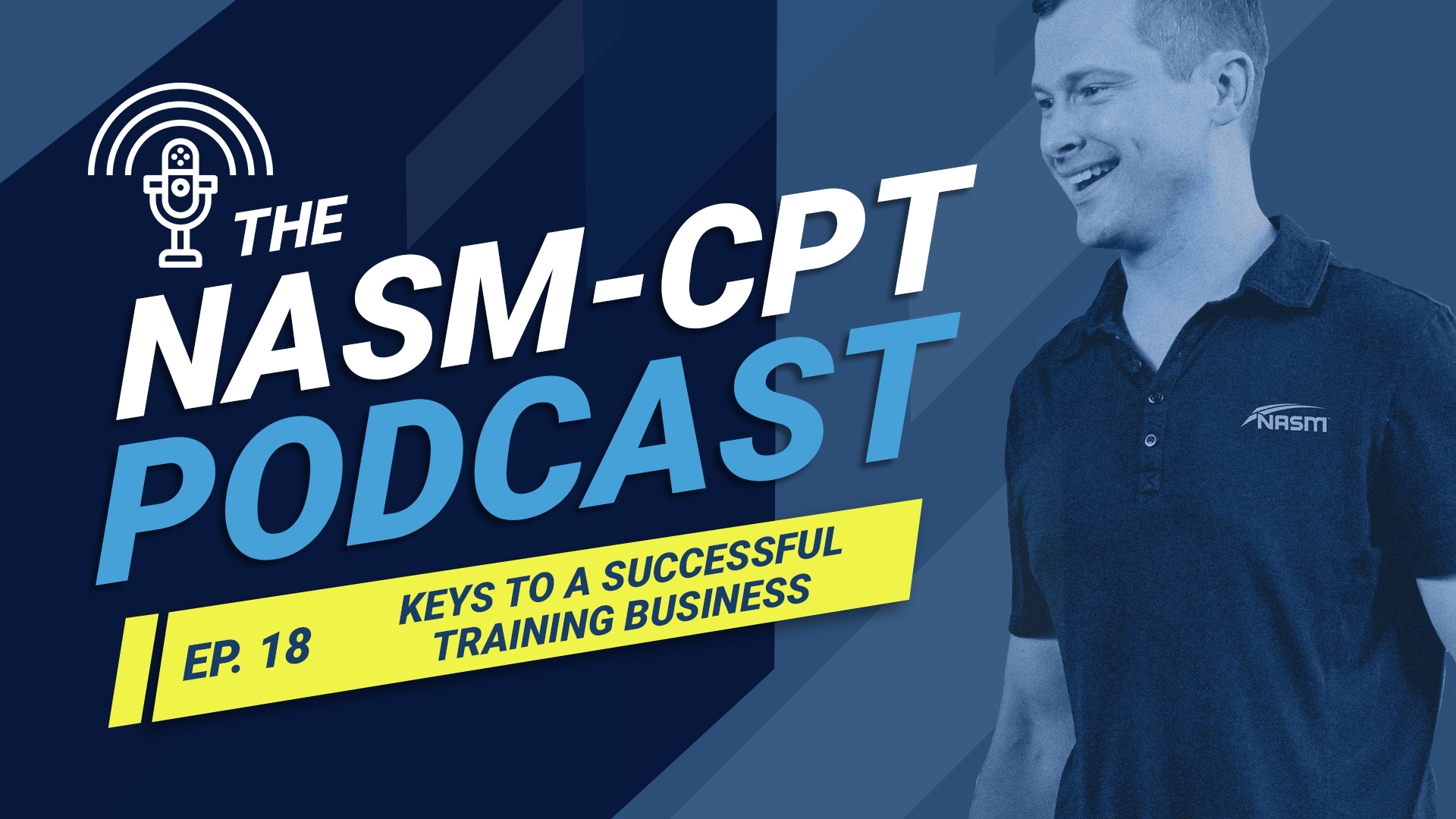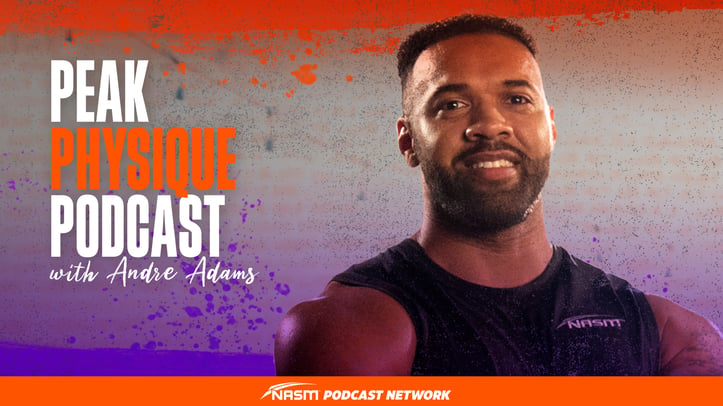Some personal trainers have an impressive list of credentials but a small client base, while others aren't as educated but are always booked. What’s the difference between them?
In this episode, Rick Richey discusses how to find the balance between these two types of trainers. Learn what it takes to run a successful personal training business, including:
- How Rick built his own business
- Your attitude and interaction skills
- What your clients really want
- Asking for the sale
- Marketing your business
- Identifying your target market
Listen to the episode to find out the keys to running a great training business.
Get 20% off your order now by calling 800-460-6276 or visiting NASM.org, and using the code Podcast 20.
SUBSCRIBE:
Transcript
You're listening to the NASM-CPT Podcast, with Rick Richey. The official podcast of the National Academy of Sports Medicine.
Welcome to the NASM-CPT Podcast. My name is Rick Richey, and today, I want to talk to you about a couple of things that have come up from people who listen to the podcast. And if you got questions about business of personal training.
And the first question was, can you provide any keys to creating a successful personal training business? And, I can. So, here goes. And, I want to talk to you a little bit about this, and you've probably seen this as an example. But, have you ever noticed that you can go into some gyms, and you see, you've got the smartest personal trainer. They have the degrees, they've got all the certifications and advanced this, and I've done that, and I've interned here. But maybe they don't have a big client base.
And then, there's another trainer there who just has a certification, and not heading up all of the very best and coolest and this and that ideas, and yet, their book is full. They're training all the time. They're busy. When they come in, they're training. And then, the smart trainer that's not training much, and then you've got the one that doesn't have as much of an education that's training all the time.
So, what's the difference between those two? And, that's really what I want to talk about a little bit, as far as keys to a successful personal training business is, how do you take the person who is that smart trainer, but doesn't have the client list, and the person that's got the client list, but could possibly be a better trainer just in general, and provide better outcomes.
Now, one of the things that you probably think about when you say, okay, well, what's the difference between these two is probably attitude. And, the person that's training a lot may be incredibly charming. They might have the best abs, and people just want to train with them for that reason. Who knows. But, there's something about this woman or man, and they train, and they got that je ne sais quoi.
I don't know, something about them that's just wonderful. But then, the smart trainer's like, "Well, I've got all the best outcomes that I can give you. I can give you the best outcomes." Why is that person not training? And, you can look at it and think, well, maybe ... And, I don't know. We're just creating hypotheticals here. But maybe they don't have the interaction skills that the other person has.
Maybe they don't have the six-pack abs, and their body is not the billboard of what you're going to see. And I'll say this, the best coaches in the world were not necessarily the best athletes. The best coaches in the world aren't the ones who can run the fastest, lift the most, and has the most accurate shot of whatever it is. You don't have to do that, to be the best coach.
So, how do we marry those two? One of the things that I also see, and this bothers me quite a bit, so please take note here, the smart trainers will also sometimes be the first to condescend the busy trainers for not being as good as they are, and not being a good trainer. And, we see this with people shaming social media people. Look, if you're a certified trainer, and that is your job, and you've got a lot of followers, good. Good, bring some more attention to our business.
You're not a certified trainer, you are not really supposed to be out there providing that input. I'm still not mad at you. I just wish that you'd go get an education to back it, right? So, that's what I'm trying to get at for this entire conversation. How do we balance that trainer that has the big client book, could use some education, how do we take the one that doesn't have the education and get them out there and producing more?
And, some of this isn't going to be ... None of it's really going to be answered on this podcast. What has to be done is, that's got to be taken care of in the gym, really. So, in the fitness facility, the management of those facilities have to look at it and say, "What are some of the things that you are not open to seeing, that maybe I can provide, and maybe you can be open to it."
Because, the smart trainer doesn't want to hear that it might be a personality thing. Or the one doesn't say, "Oh, I've got too much training to do, so I can't take time off to go get education." Well, first of all, that's what podcasts are great for. So, podcasts are going to make that much easier for this person to just plug in and listen to education. There are no podcasts out there that says, "Hey, smart guy, this is how you're going to build your business."
And, it was difficult for me to build mine. And, I wasn't the smart guy trainer. I was interested, though. I was interested in multiple things. Building a business, right? Giving the clients what they want, and then also providing the best thing that I can do. And, that's really what I want to pay attention to just for a moment is, just because you're the smartest person, doesn't mean that person wants to work or train with you. So, how do we do that?
You really have to look back and find out, what do clients want? Now, if they want you to have six-pack abs, and that is just not in your future, those are not your clients, so don't worry about that. You don't have to deal with those people. But what we do is, we think people want the smartest person when really, people want somebody that's competent and capable, and in some instances, the smartest. But ultimately what they want to do is, they want to feel comfortable. They want to feel like you're listening to them, and they want to feel like they're going to get their outcomes. But, you got to make me feel good when I'm doing the work.
And, one thing that we know from the science and motor learning, and how people develop is that, people who are new to something need that feedback and that constant support, and that, "Yeah, you're doing a good job." And, "Go get them, tiger," and that kind of stuff. So, if you got the trainer that maybe is not the best, but man, what a motivator, how can you implement something like that, without changing your character or who you are and stuff.
You know what I mean? But, you've got to go in and say, "What can I provide now that I'm not doing?" And, just like the other trainer, you are going to be in an uncomfortable position, and that will encourage you to start getting comfortable with being uncomfortable. That's how you challenge yourself.
So, you got to challenge yourself in multiple ways. Getting out there, talking to people. When I first became a personal trainer and I say, "Hey, how do we get clients?" And the guy goes, "Go talk to people." New York City, hard trainer, hard manager. You got to go talk to them.
"Oh, just like, how?" He goes, "Get out of here before I throw a 45-pound plate at you. Get out of here, and just go talk to people." I was like, "All right."
So, what I did instead was, try to figure out and strategize how I was going to talk to people, because I wasn't comfortable just walking up and talking to people, because I know how that would make me feel. The first thing I feel, if you're going to walk up and talk to me as a personal trainer is that, you're about to sell me something.
So, the first thing that you should do as a personal trainer is ensure the person you're about to talk to that you're not going to sell them anything. Make that introduction. Walk over, hand them a towel and say, "Hey, my name's Rick. If I can help you with anything, let me know." That's it. You laid the groundwork. Simple, easy. Now, that person doesn't feel like you're going to try to sell them, and hopefully, you have gotten that person's name.
Once you get that person's name, write that name down in the notes app on your phone so that ... And, a physical characteristic so that you can look back and say, "Oh, I know that person. I don't know their name. Oh, yeah, that's the person with the pink hair." Whatever, you write that down and you have their name next to it, and now you know their name. Because, I've been in a room in an office, my glass office looking out when I was managing, and saw somebody that I wish I'd talked to the day before. And, I see them today, and they're doing something that's a little bit spooky for them to be doing, and it's potentially contraindicated, and I wanted to walk over there and say, "Hey, Rob ... " or Tom, or whoever it was. But, because I didn't get their name yesterday, I couldn't do it today.
So, you know what I'm doing for the first time? Introducing myself and letting that person know that they're doing something that's contraindicated or dangerous. And, that is not how you want to engage a conversation. So, just meet people. Talk to people. Just say hi. And, the number one thing that I tell people to do is to be nice. Be nice, and not being mean are not the same thing.
If you walk by me and I didn't trip you, right, that's me not being mean. But I wasn't necessarily nice just because I didn't trip you when you walked by. So, what does that mean? When you walk by, and I just provide a greeting. "Hey, good to see you today. Have a great workout." That is being nice, all right? I didn't try to sell you, didn't try to get money from you. I'm just trying to get you to be comfortable with who I am. And I will tell you this, strategically for me, I have gotten more business by not asking for business because I was nice to people and just wanted to say hi. Just wanted to greet people and let them know I'm here.
I also got the most business of any business when I was working was two things. One, when I was working out. So, not necessarily when I was wearing the trainer uniform. And, I had the tag around, my name tag. And, like, prim and proper version of what I should be as a trainer when I'm walking around on the floor, but when I looked like them, when I was working out. And they felt more comfortable. Now I'm a real person now. Now they can come up and ask me a question. They can talk to me. And, they did.
I built a lot of business, just from my own workouts. And then, also looking at different ways to build business, I cleaned the gym all the time. And, one thing that was fearful of is, I just didn't want people to think that I was cleaning the gym, so that I was maintenance staff. I had a lot of catch ups about that, like, I just was getting caught up on what they would think of me. But at the same time, I was bored out of my mind as a floor trainer, and when a session, I wasn't training sessions, I'd rather just be cleaning up.
People would tell me all the time, "I wanted to talk to you, because you're really one of the only trainers that were actually doing anything in the gym. It looked like it was something that was important to you." It had nothing to do with training. And here's the other thing, if you have a fitness facility, a gym, where you offer complimentary sessions to new members, introductory sessions, do as many of them as possible. Do them for free, if that's the case, but do as many as possible, because listen to this, people love to train with trainers that train.
They don't know that you're giving away a free session. They don't know that the six people you have lined up today are six complimentary and introductory sessions. You know what people see? You're busy. You are working, and people love to work with people that work. And then, can they vibe with you? And, you're not going to win everybody. You're not going to be comfortable with everybody. I don't want you to be uncomfortable. But, it's not going to be the best relationship with anybody.
As you build your business, you can start deciding what that looks like, when you can train, who you can train with, what is your niche, who's going to come in and be a client. Until that, you got to be a catch all. Don't train with anybody that makes you uncomfortable. Don't do that. But, it's not going to be the best relationship. You're not going to be friend with everybody. And then, be careful about the friendship thing. Because, one of the biggest complaints as a manager that I would get were, people would always say, "The trainer, they worked really well for awhile. And then, it's like we became friends, and they just talked the whole time. Or, they'd tell me about their girlfriend or their boyfriend, or their weekend, or ... " Clients love this. How, "Oh my goodness, I eat so much, and I never gain weight."
Don't say that. That's dumb. Don't say that to your clients. Clients that are coming in trying to work out, and probably lose weight don't want to hear how difficult it is for you to gain weight because you eat whatever you want. Don't do that, guys. Like, we shoot ourselves in the foot sometimes, and we don't think about it.
Also, concerns for people in the gyms is sometimes, you just don't feel like you're worth it. You're asking somebody to pay upwards to a hundred or more dollars, in some cases, to train with you, and you're a new trainer. And, you do those complimentary sessions, and you're like, "Man, I just feel uncomfortable asking for money. I feel uncomfortable asking for the sale."
So, here's what I want to do, to speak to that. First of all, don't feel uncomfortable. Because, if you work for a gym, the gym charges what the gym charges. That's what their rates are. You can't change that. You can't offer free sessions or discount sessions. All you can do is say, "This is the session I gave you. I did the best I could. If it seems like what we did together today will help you get to where your goals are, these are the prices I'd love to work with you. Let me know if that's something that you would like to do. You don't have to tell me right now, but I would like to encourage you, if this feels like something that's going to help you get to your goals, let me help you do that." And, that, my friends, that's it. You don't have to keep pushing. You don't have to keep ...
You might want to do a follow up email, text, phone call, whatever way that they would like to be communicated with, keep an eye on that one. But, you can't change the prices, so don't feel bad about the prices. You work at that facility, you charge what you got to charge, all right? So, don't feel like you cannot ask for money.
And the other thing is, you have to ask for the sale. You have to. Not when you're out on the floor. Not when you're just meeting somebody. But, when you're in that one on one session, that complimentary session, you have to ask for it. Do you know how many times I didn't ask for something? And, people didn't just offer. But, when I started asking for it, then people started thinking, oh, maybe. Yeah, yeah, it does sound like something nice that I should do.
It's because you have to ask. You can't not ask. It is your job to ask, which is the other thing. So, ask it, but don't feel uncomfortable asking it. Why? Because, you did the best you could in order to make it happen. Now, let's move into an entrepreneurial experience here. So, you got this entrepreneurial bug, and you want to start marketing yourselves. One of the things that I find interesting ... This is when you can start charging your own prices, right?
And, one of the things I find interesting, I was listening to a woman the other day. She was on Instagram, and she was giving this whole thing about, "Just tell me how much money you want to make as a personal trainer. You got to put that down. So, if it's a hundred thousand dollars, then put down a hundred thousand dollars. And, you only want to work 20 hours a week, and you only want to work 40 weeks out of the year, then do all that math. Divide it by this, and now, you should charge 175 dollars per session."
Oh yeah? Really? I just ask for 175 dollars per session, and people will give that to me, because if I knew that, I would have done that a long time ago, just to ask for ... As a matter of fact, I want to make more than a hundred thousand dollars. So maybe, maybe I should just say I want to make 200 thousand dollars. And then, we do all that math, I doubled the price. So now, my training rate is 350 dollars per session. Boom. Got it.
That's not how it works. I think that she was right in one aspect of it. Find a reasonable number that you would like to make, and figure out how to make it. But, if you are soaring above industry standard, then you may get a client that pays you 175 dollars a session. And, you may train that person two times a week, maybe. Maybe.
But, at the end of the year, you ain't making a hundred thousand dollars off of that. You're not making close to it. Not even close. That's if you train four sessions a week then, at under a hundred dollars is not going to get you anywhere close. You understand? The math doesn't work out. You can't go beyond an industry standard unless there is a market for it, and you are in that market. You have to be in it, and then, you have to match that market, which means you have to have the skillset. You have to have the ability. You have to have the understanding, and you have to have those connections.
Otherwise, you got to start simple. And, what is the easiest way to start? Well, first of all, you got to have a base. Who's your client? Because if you're working at being an entrepreneur, then that probably means that you've worked for somebody else, and you've built a base of clients. You've got people who already love you. You've got, as Peter Shenkman has in his book, Zombie Loyalist, you've got zombie loyalists. They're going to follow you wherever you go.
You're going to train at this location, they're going to that location to train. You go five, 10 miles out of the way for them, they are still going to go five to 10 miles out of the way, just to train with you, because you are their trainer. They're not going to a location. They are going to you for you to train them.
Well, how do you get those zombie loyalists? How do you get those ravenous fans? Well, you got to start somewhere. You got to have a base. Sometimes, that base has to start with friends and family. Sometimes, it starts with a following that you already have. You got to start somewhere, right? So, if you're looking to make that jump, you got to make that jump. And, it's going to be uncomfortable sometimes. And, some people will win at it, and some people will not, which is why I also say like, if you work for a big gym, don't just stop training at that gym to go independent and build your own business, or to build your own facility or your own location. You need to strategize what you're going to do, and you have to have a cushion before you jump.
And then, you got to market your services. You got to market those services. You need to have a social media presence. I'm not saying you're going to get a lot of business from your social media. I think that that is one of the biggest fallacies is that, social media is going to build your business, and you're going to get a lot of business, because you have a lot of followers. That's not how that world works.
However, it is a presence, and you need to be a presence. And, you need to be presentable. And what I mean by that is, there needs to be a social media strategy. It can't just be a picture of you, and then there's a picture of your cat, and then there's a picture of what you ate, and you're not providing any substance to what you're doing. People want to get to know you as a person. But, too many cat pictures, too many cat pictures, they don't want to know you anymore. They're like, "Oh, that trainer had some cool stuff. But then, cats, and I got to go." Right?
So, set out a strategy, a series of columns that you're going to hit this column, this column, and this column every single week, and even if you only post three times a week, create a strategy that you're going to post around. And, that can include pictures of your kids. It can include pictures of your cat, I guess.
But, but what it really needs to do is, show you and who you are, and show you as a professional and a person. So, understand that social media. You should also host events. If you want to get out there and see people, host events. Free workouts, free workshops, free educational content, free setup for the American Diabetes Association. Free setup to work with the American Heart Association, your local chapter, in order to help people. Not just to drive business, but to help people, and helping people may then drive business your way. But, your ultimate goal should be to help people.
So, support a cause with the events that you're doing, as well. And then, you're going to need a sense of direction and an area to focus on. Like I said earlier, when you're a young trainer, you got to be able to train everybody. Somebody wants to run faster, jump higher, lose weight, gain flexibility, you might not be the best at any of them. You're not going to be, because you're going to be a relatively new trainer, unless you became a relatively new and young trainer after being some type of professionally trained athlete, dancer, martial artist, and they're focusing on athlete, dance, martial arts. It doesn't mean you're a good trainer, trainer.
So, you're going to have to focus a little bit on everything. If something's out of, making you uncomfortable, this person has a shoulder injury, and they need help strengthening your shoulder, if that's not your thing, don't work with that person. Send them to somebody else. But, create a market with people, too. Get to know group fitness instructors. Group fitness instructors may also be personal trainers, but they cannot train everybody that asks them if they're a trainer, because they get asked all the time. If you'd like to be a group exercise instructor, group fitness is a good way to drive training business to you, as well.
Identify who your target market is. As you get better, start to develop a niche. Mine's corrective exercise. It's my primary focus, and I use that even with elite and professional athletes that I work with. I focus on corrective exercise. I don't focus on necessarily performance enhancement strategies. I focus on corrective exercise that allows performance to be enhanced with those training clients. It doesn't mean I don't do it. I'm capable. I'm skilled and educated in it. It's just not my primary focus. So, if somebody came to me and said, "Hey, I don't really want to focus on corrective exercise. I just want to focus on Olympic lifting," you're not my client, man. You're not my client. That's not for me.
So, I'll connect them with somebody. And then, what are the outcomes that you can provide to your target market? That's it. Identify your target market. Identify what the outcomes are. And then, you can really start marketing yourself to the specific group of people that you would like to work with. And, it's interesting, because that stuff changes over time. Everybody thinks you're going to work with athletes. Every single trainer, when they start out, almost, says, "Ah, I'm going to work with athletes, an I want to work with athletes, and maybe every once in a while ... Only athletes." Right? And, that's who they want to work with. That's not going to be your market. I'll tell you right now, you may be the diamond in the rough on that one. Start focusing on weight loss clients. Start focusing on geriatric clients. Start focusing on, have friends that work with amputees, and that's never something that they thought they would be working with, a demographic they'd be working with. And now, it's their primary focus.
You're going to be working with people that you never thought would be your primary focus, but gain that focus. It also doesn't mean you're not ever going to have a traditional client. And you may also say, "Hey, I'm going to work with weight loss clients, and that's my thing. It is my thing." And, you own that, and then you market it. So, when somebody says, "Hey, I want to go to a client to lose weight," and every trainer goes, "Oh, everybody does that. Everybody helps people lose weight." But, you're the trainer that says, "No, that's all I do. I work with weight loss clients. That's my thing." Who are you going to work with? You're going to be like, "I'd rather just go to the weight loss client guy. That's kind of his thing."
Anyway, I hope that helps. Marketing, who's your target market? Build a following. You know, ask for the sale. Don't undersell yourself, but certainly, don't oversell yourself either. And, if you're that person that's very smart, and needs to get out there and talk to people, you got to get out there and do that. And, stop selling how smart you are, because you're focusing on you. Talk about what you can do, can help them. That's what people care about. People don't care about you. They don't know you. People don't care about you.
And you get the client that says, "Hey, I'm focused on you. I'm focused on you and I'm the best." And, I'm not necessarily the best, but he's the one that's training all the time, when you go back and you get more education, you are still focusing on them. You're focusing on your clients. I hope this helps. My name is Rick Richey. Reach out to me, @dr.rickrichey, R-I-C-H-E-Y, on Instagram. Hit me up at rick.richey@NASM.org, or hit up NASM on any other social handles, and let us know what you'd like to talk about. But, these are two requests that were put out there, what are the keys to successful training in the business, and then marketing yourself, if you've got the entrepreneurial bug. So, I hope that helped. Thank you so much for listening.

















